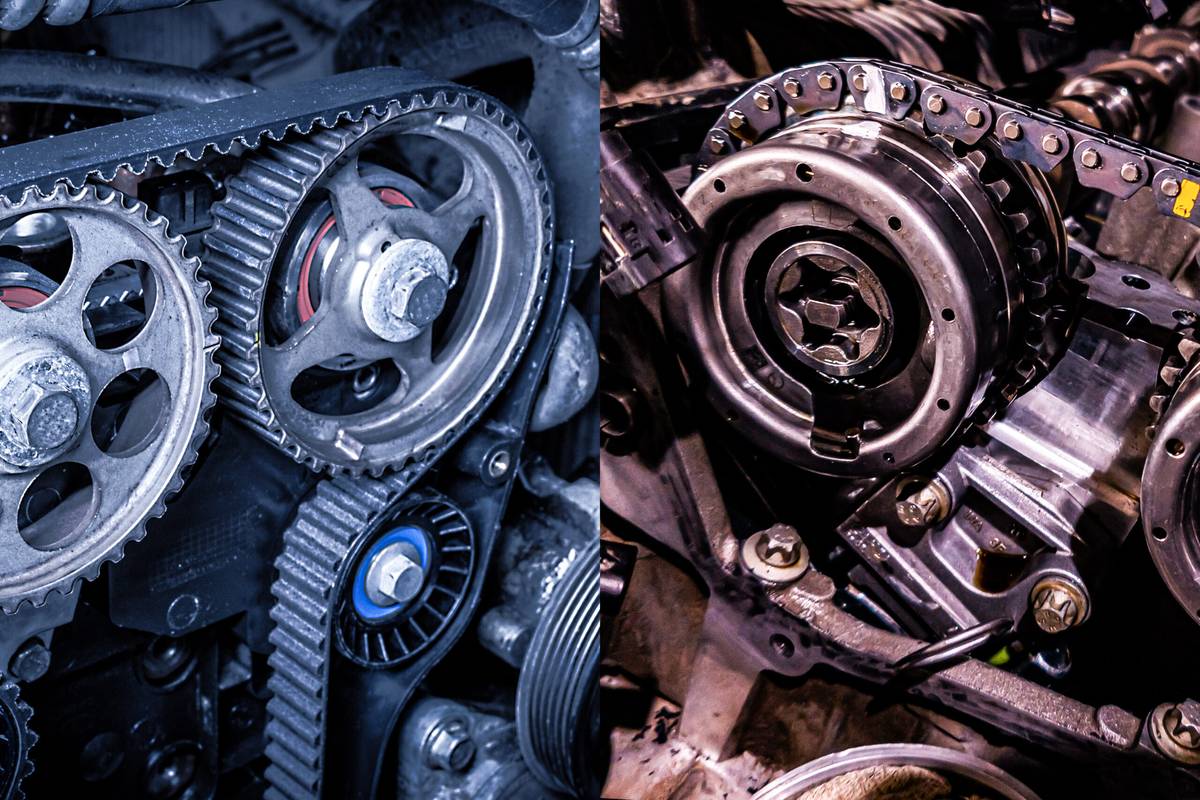Timing Belt Vs. Timing Chain

Many modern passenger cars have either a timing belt or a timing chain. Generally speaking, timing belts have the advantage of being quieter and cheaper to produce and replace, while timing chains typically have a longer lifespan. But why should you replace your vehicle’s timing belt or chain, and how do you find out which one your car has?
Related: Is Your Check-Engine Light On? 5 of the Most Common Causes
What Does the Timing Belt or Timing Chain Do?
On a conventional piston engine — which is found in virtually all modern passenger cars — the up-and-down motion of the pistons turn the crankshaft, and the crankshaft turns the camshaft, which opens the valves at the proper time. What typically connects the crankshaft to the camshaft is either a cogged timing belt riding on pulleys or a timing chain riding on sprockets. (Both setups look somewhat like a bicycle’s chain and sprockets.) If the timing belt or timing chain fails, the engine stops running immediately, potentially resulting in expensive internal engine damage.
One element that factors in here is whether your car has an interference (or non-freewheeling) engine or noninterference (or freewheeling) engine. With an interference engine, the pistons will hit and usually bend some of the valves if the timing belt or chain breaks, causing major internal engine damage that can be expensive to repair; in a noninterference engine, no internal damage should occur. With either type, the engine will stop immediately if the belt or chain breaks, leaving you stranded. Thus, if you have an interference engine with a timing belt, it’s much more important to replace the timing belt at its recommended intervals.
Which Is Better?
Though it’s certainly a matter of opinion that’s based largely on your priorities, it’s generally felt that timing chains are better than timing belts. While most timing belts are supposed to be replaced every 60,000 to 120,000 miles, many timing chains end up lasting the life of the car. That can be significant because replacing a timing belt is a fairly complicated job that can easily cost $500 to $1,000. Note that in some cases, the manufacturer might include a time interval — not just a mileage interval — for recommended timing belt replacement. There might also be other parts that would be prudent to replace during the process … at additional cost. More on that in a bit.
Why Do I Have to Replace My Timing Belt if My Engine Is Running Fine?
The reason you should replace a timing belt at recommended intervals is that it can fail without notice. Even if the timing belt doesn’t break, worn cogged “teeth” or a bad tensioner could cause it to skip and possibly have the same effect, though that might give you a bit of warning in the form of an engine misfire or ticking noise.
Timing chains aren’t infallible, either. Even if they don’t break, there are tensioners and guides that can wear out and need replacement. If the chain itself ever needs to be replaced, it can be more expensive than installing a new belt. If the timing chain or any of its associated parts are going bad, they’ll often generate some unusual noises, such as a rattling sound. As a timing chain is lubricated by engine oil, changing your car’s oil at the recommended intervals can help extend the chain’s life.
Of course, if you buy new cars and only keep them for 50,000 miles or less, none of this is as likely to affect you.
How Do You Know Which Your Car Has?
If you check the maintenance schedule for your car, which may be found in the owner’s manual, look for something that indicates when you should change the timing belt. If applicable, the interval is usually listed between 60,000 and 120,000 miles. If it’s not listed, your car probably has a timing chain. You can keep searching to higher mileage intervals to see if the timing chain is ever recommended to be replaced.
If you don’t have the maintenance schedule, you can usually find the necessary information online using your vehicle’s make, model and model year. For instance, you could search, “Does the 2009 Chevrolet Malibu with a 2.4-liter four-cylinder engine have a timing belt or a timing chain?” You can do the same to determine whether it has an interference or noninterference engine. If it has a timing belt, you can possibly also find the recommended replacement intervals.
Some Added Extras
Particularly on cars that have a timing belt that also turns the water pump, many mechanics might recommend you replace the water pump when you replace the timing belt even if the water pump isn’t bad. That’s because a water pump failure down the road can affect the “timing” of the timing belt, which could cause engine damage just as if the belt broke. Furthermore, if you have to replace the water pump later due to leaks, the vast majority of the cost will be in labor, much of which you’re already paying for when replacing the belt.
Note that many racing cars and heavy-duty diesel engines — along with some older cars — have timing gears instead of belts or chains, as the gears are usually very durable and don’t require any maintenance. However, timing gears aren’t generally used in normal passenger-car applications nowadays, likely due to high cost and the fact that they often make a loud whirring sound that buyers might find objectionable.
More From Cars.com:
- What Is a Cam?
- What Is a VVT-i Engine?
- What Fluids Should I Top Off?
- What Is an Actuator?
- More Service News
Related Video:
Cars.com’s Editorial department is your source for automotive news and reviews. In line with Cars.com’s long-standing ethics policy, editors and reviewers don’t accept gifts or free trips from automakers. The Editorial department is independent of Cars.com’s advertising, sales and sponsored content departments.
Featured stories



